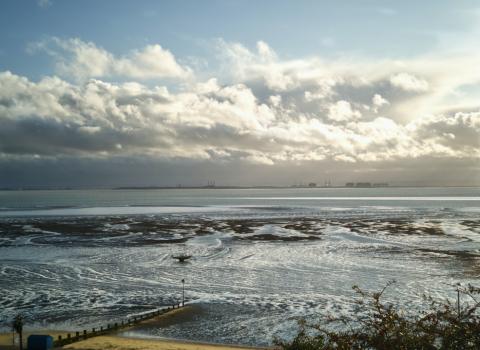The SEARCH project will evaluate climate flooding hazards in UK estuaries. It will combine past and new observations with UKCP18 projections of precipitation, temperature, fluvial flows, groundwater flows, storm surge and sea level, applied to a fast, tested and open-source hydrodynamic-groundwater model.
Background
Estuary communities are especially vulnerable to future changes in flood risk. Climate change will lead to rising sea-level, increases in storm surge heights, changing precipitation and temperature patterns that will combine to have profound impacts on fluvial behaviour.
Twenty million people living near UK estuaries are at risk from the compound effect of these hazards. Recent, near miss flooding in UK catchments and estuaries (which still caused extensive damage costing £500 million) show how flooding could have been much worse had there been small changes in the timing and intensity of the rainfall.
Considering the high socio-economic and environmental value of estuaries, the complexity of compound hazards, the projected changes in drivers, and unregulated land use management, it is timely to develop new strategies to alleviate the impacts of compound flooding and to develop improved risk assessment tools for flood protection.
Approach
Working with the UK regulators of flooding, SEARCH will use past and new observations with UKCP18 projections of precipitation, temperature, fluvial flows, groundwater flows, storm surge and sea level applied to a fast, tested and open-source hydrodynamic-groundwater model to simulate flooding hazards. SEARCH will simulate 14 systems that cover the range of locations and estuaries within the UK.
This novel method will be designed to be fit-for-purpose for compound flooding events across different spatial and temporal scales, and for different catchment and estuary types, accurately resolving hydrological and marine processes and their joint-probabilities. It will also evaluate how climate predictions from UKCP18 downscale to flooding impact.
This will provide unique inundation and likelihood data for the Environment Agency, Natural Resources Wales, and Scottish Environment Protection Agency, crucial for identifying the most vulnerable communities so they can manage resources effectively during flood response.
Additionally, the project will show how compound flooding occurs and how sensitive different estuary systems are to the drivers of climate change. Global sea levels are expected to rise up to 1 meter this century. In the UK, precipitation and temperature distributions are likely to change, with storms, heatwaves and droughts becoming more intense and seasonal with altered timings. These changes in the intensity of flood drivers, as well as their relative timing, will affect the severity of the hazard and, thus, the level risk.
Outputs
- SEARCH will collect new observations of extreme water levels, where data is sparse in the mid-estuary away from tide and river gauges.
- The project will deliver a new analysis of the behaviour, variability, trend and joint-probability of the past and projected future drivers of estuary flooding.
- It will also produce a new method and new coupled model for simulating flooding impact into the future.
Publications
- Robins PE, Lewis MJ, Elnahrawi M, Lyddon C, Dickson N and Coulthard TJ (2021) Compound Flooding: Dependence at Sub-daily Scales Between Extreme Storm Surge and Fluvial Flow. Front. Built Environ. 7:727294.
- Harrison, L.M., Coulthard, T.J., Robins, P.E. et al. (2022) Sensitivity of Estuaries to Compound Flooding. Estuaries and Coasts 45, 1250–1269 .
Picture credit: Thames estuary, Unsplash.

